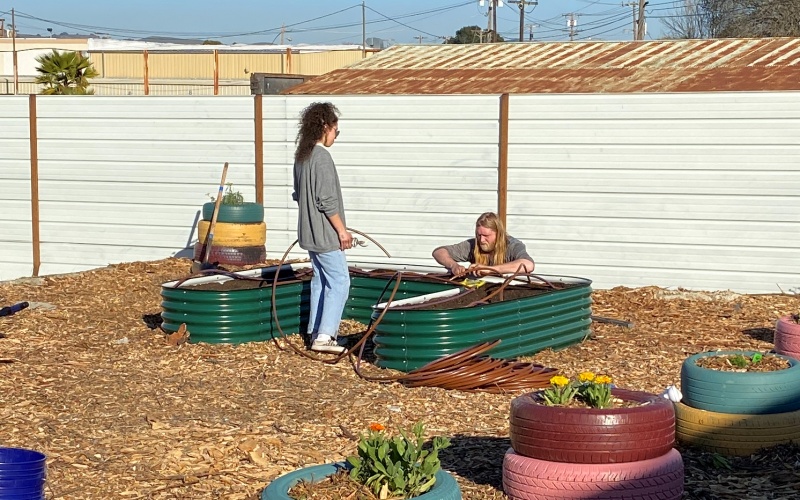2024 Benicia & Vallejo Tour: Featured Gardens
The Curious Garden
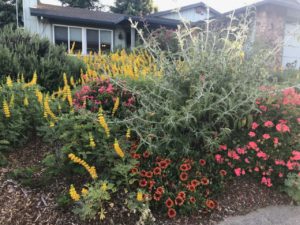 Mature front yard food forest has mostly fruit trees and native plants that attract pollinators year-round. It has a laundry-to-landscape greywater system.
Mature front yard food forest has mostly fruit trees and native plants that attract pollinators year-round. It has a laundry-to-landscape greywater system.
The homeowner started gardening while living in San Francisco, and took a semester-long Garden for the Environment class on all aspects of gardening including permaculture. The family moved to Benicia about 12 years ago, partly so they could have space to grow a garden.
The family has enjoyed growing their own food and exploring the changing yard and the wildlife it attracts. It also has a very steep hill, which presents its own unique issues — and a great canvas for growing yellow lupine among the other native plants.
Giardino su una Collina (Garden on a Hill)
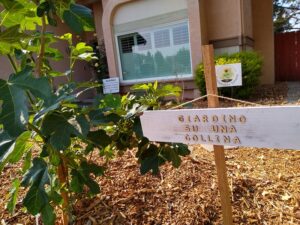 A 4-year-old food forest and pollinator garden installed in 2020 that includes a swale that captures roof water and mediterranean trees and plants mixed with native pollinating and nectar plants to attract bees and butterflies. This site is home to a Monarch Waystation that grows a variety of plants to support Western Monarch Butterflies.
A 4-year-old food forest and pollinator garden installed in 2020 that includes a swale that captures roof water and mediterranean trees and plants mixed with native pollinating and nectar plants to attract bees and butterflies. This site is home to a Monarch Waystation that grows a variety of plants to support Western Monarch Butterflies.
The Monarch Milkweed Project and monarch education will be highlighted. Come to learn how you can support and participate in the Bay Area Butterfly Festival coming to Mare Island on May 19!
Greyhawk Grove
 A 9-year-old established food forest with two swales that are dug out and refreshed every 2-3 years, laundry-to-landscape greywater to fruit trees, and chickens. The drip irrigation system was removed four years ago and the garden is thriving! Annual beds are hand-watered once a week during the growing season. Greyhawk Grove is a “high-traffic-survival-of-the-fittest-have-three-young-children garden”. There may be lemonade and baked goods for sale by children, as well as products from the garden to give away (dried calendula, lavender, herbs, eggs, fruit, etc.).
A 9-year-old established food forest with two swales that are dug out and refreshed every 2-3 years, laundry-to-landscape greywater to fruit trees, and chickens. The drip irrigation system was removed four years ago and the garden is thriving! Annual beds are hand-watered once a week during the growing season. Greyhawk Grove is a “high-traffic-survival-of-the-fittest-have-three-young-children garden”. There may be lemonade and baked goods for sale by children, as well as products from the garden to give away (dried calendula, lavender, herbs, eggs, fruit, etc.).
Living and Learning
Established front yard food forest that replaced a lawn in 2016 with 2 swales, a laundry-to-landscape greywater system and a diverse group of plants and fruit trees that has now expanded throughout the property. Small spaces for relaxing and enjoying are throughout the garden. One of the food forest keepers is a teacher and will be present to share knowledge about growing and preserving tomatoes.
Wild Cherry Way
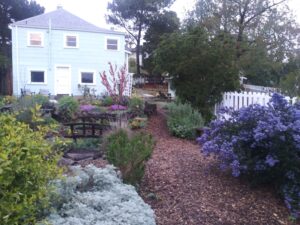 Southern slope food forest focused on pollinators, shrubs and native plants. It also includes fruit trees, perennial and edible plants, swales and a laundry-to-landscape greywater system.
Southern slope food forest focused on pollinators, shrubs and native plants. It also includes fruit trees, perennial and edible plants, swales and a laundry-to-landscape greywater system.
Permaculture Consultant Ron Kane will be on-site to offer tours and answer questions.
Yggdrasil Garden
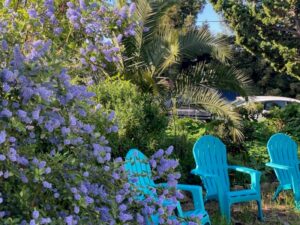 An evolving food forest garden and greywater system installed as part of Sustainable Solano’s 2022-23 Permaculture Design Certificate course. Students transformed the front yard with a rain-capturing swale and planted berms in holistic workshops. The west side yard’s raised vegetable bed and passionfruit vines are watered by a laundry-to-landscape greywater system and include edible plants and native pollinators. The monarch butterfly-hosting back gardens are designed and maintained by permaculture designer Michael Wedgley’s Soilogical, nurtured with specially prepared compost, and supported by Seth Wright’s Water Service Irrigation design created as part of a Sustainable Solano irrigation class. An herb spiral was created with bricks repurposed from the chimney of the circa 1850s historic home, retaining walls from pieces of historic on-site stables, and patios from slate and brick on-site. The east side yard (in development) is watered with both a rain-capturing swale and a laundry-to-landscape system and will have an aquatic garden and feature scented contributions to the edible landscape. Displays feature the historic aspects of the home; its background and ongoing tradition of art, design, and healing; information about the Ohlone Sogorea Te Indigenous Land Trust and rematriation of Carquin land; and the garden’s first tree guilds: persimmon, apricot, fig, passionfruit guava, and meyer lemon.
An evolving food forest garden and greywater system installed as part of Sustainable Solano’s 2022-23 Permaculture Design Certificate course. Students transformed the front yard with a rain-capturing swale and planted berms in holistic workshops. The west side yard’s raised vegetable bed and passionfruit vines are watered by a laundry-to-landscape greywater system and include edible plants and native pollinators. The monarch butterfly-hosting back gardens are designed and maintained by permaculture designer Michael Wedgley’s Soilogical, nurtured with specially prepared compost, and supported by Seth Wright’s Water Service Irrigation design created as part of a Sustainable Solano irrigation class. An herb spiral was created with bricks repurposed from the chimney of the circa 1850s historic home, retaining walls from pieces of historic on-site stables, and patios from slate and brick on-site. The east side yard (in development) is watered with both a rain-capturing swale and a laundry-to-landscape system and will have an aquatic garden and feature scented contributions to the edible landscape. Displays feature the historic aspects of the home; its background and ongoing tradition of art, design, and healing; information about the Ohlone Sogorea Te Indigenous Land Trust and rematriation of Carquin land; and the garden’s first tree guilds: persimmon, apricot, fig, passionfruit guava, and meyer lemon.
There will be a water harvesting guided tour with designer Michael Wedgley from 10:30-11:30 am, and PERSONA will perform live acoustic pop/R&B songs from 12-1 pm.
Inspired Garden
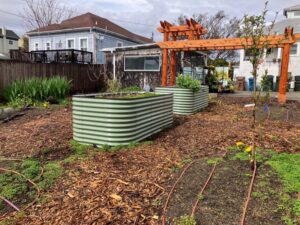 This homeowner attended our tours and was inspired to transform his yard! This garden, designed by Michael Wedgley of Soilogical, is a unique opportunity to tour a stunning and sustainable backyard that showcases the beauty and abundance of permaculture. This eco-conscious backyard features a rainwater catchment system that can harvest up to 3,500 gallons per year, helping to restore the on-site water table, and providing an abundant source of water for this permaculture food forest.
This homeowner attended our tours and was inspired to transform his yard! This garden, designed by Michael Wedgley of Soilogical, is a unique opportunity to tour a stunning and sustainable backyard that showcases the beauty and abundance of permaculture. This eco-conscious backyard features a rainwater catchment system that can harvest up to 3,500 gallons per year, helping to restore the on-site water table, and providing an abundant source of water for this permaculture food forest.
The carefully designed irrigation system utilizes drip irrigation, which not only lowers water usage but also promotes water conservation. This 1-year-old garden boasts over 80 different species of perennial plants, many of which are edible. You’ll be amazed at the variety and richness of the plants that are flourishing in this environment.
Colibri Ochoa (Hummingbird Ochoa)
Front yard food forest garden has a laundry-to-landscape greywater system, a swale, repurposed logs to create planting areas and a variety of plants to provide food for people and pollinators. On the day of the tour there will be a laundry-to-landscape greywater education in Spanish and a translator on-site.
Sustainable Solano partnered with two other organizations to install this garden in 2021 and begin to provide resources in Spanish. Planting Justice partnered with Sustainable Solano on a Spanish-speaking installation. They offer permaculture services and also have an organic nursery in Oakland that sells rare and heirloom varieties. Club Stride translated an educational program about Patio Sostenibles and created a food forest video in Spanish, Entrevista de Patio Sostenible. Both organizations are doing incredible work to reduce inequities. Check out their websites to find out more on how to support their work.
Enchanted Cottage Garden
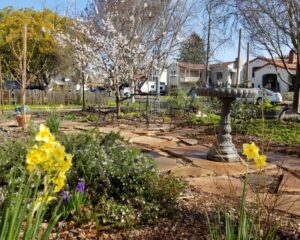 This front yard lawn was replaced in May 2017 with two swales, above-ground rainwater collection and a variety of fruit trees, grapes, herbs, and year-round pollinator plants mixed with annual vegetables. There is a path through it with seating for anyone who walks by. The food forest concept extends to the back garden. This yard has inspired several neighbors to transform their landscapes. Produce from the garden is used in the food forest keeper’s small home-based restaurant and they donate excess produce.
This front yard lawn was replaced in May 2017 with two swales, above-ground rainwater collection and a variety of fruit trees, grapes, herbs, and year-round pollinator plants mixed with annual vegetables. There is a path through it with seating for anyone who walks by. The food forest concept extends to the back garden. This yard has inspired several neighbors to transform their landscapes. Produce from the garden is used in the food forest keeper’s small home-based restaurant and they donate excess produce.
Learn about supporting local food in Vallejo.
First Christian Church
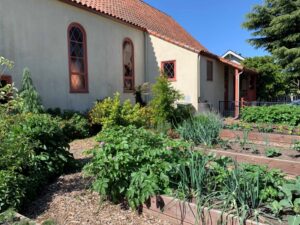 Two separate gardens, one is a peace garden with mostly flowers, cactus and trees and the other is the vegetable garden, called Johnson Ranch. The vegetable garden was revived through the Solano Gardens program. The food grown is donated to the local food pantries (Faith Food Fridays, Amador Hope Center, etc.).
Two separate gardens, one is a peace garden with mostly flowers, cactus and trees and the other is the vegetable garden, called Johnson Ranch. The vegetable garden was revived through the Solano Gardens program. The food grown is donated to the local food pantries (Faith Food Fridays, Amador Hope Center, etc.).
Solano Gardens Program Manager Jazzmin Ballou will be on-site to highlight opportunities to get involved with local community gardens and available to discuss interest in future community gardens within the county.
Loma Vista Farm
The Food Forest Garden is an extra special garden at the Farm. It provides a beautiful demonstration to the many thousands of people that visit each year on how to plant their own yard in a variety of fruit trees, perennial vegetables, herbs, native plants and pollinator plants. Volunteers will be available to show visitors the Food Forest Garden. The Farm will close promptly at 4 pm.
The tour will be on the same day as Loma Vista Farm’s annual Spring Open House, making it an extra special day to visit. The Farm event begins at 11 am and ends at 3 pm. Please come before 3 pm if you would like to enjoy both events.
As part of the Farm event there will be a plant sale in the greenhouse of natives, herbs, vegetables, and pollinator plants. The students from Loma Vista Environmental Science Academy produce these plants as part of their weekly farm science lessons.
Pick up a scavenger hunt sheet for a fun way to explore the gardens!
For more information check out: Lomavistafarm.org.
Loam Sweet Loam
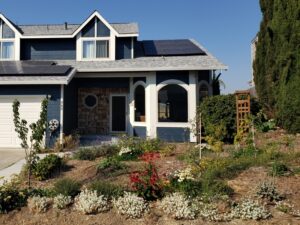
This 18-month-old, 700-square-foot front yard food forest is sheet mulched and includes a swale. It includes multiple layers of permaculture plants, including young fruit trees, drought-tolerant shrubs such as rosemary and lavender, and soil-amending groundcovers.
The homeowners extended permaculture principles into their 900-square-foot backyard vegetable garden with the addition of a laundry-to-landscape greywater system to irrigate young fruit trees. Future plans include diverting rainwater from downspouts into existing rain barrels to irrigate the yard, expanding the area irrigated by greywater to incorporate more trees, and increasing plant diversity throughout the yard to support a strong and edible ecosystem.
Join Trish Barnes from 1-3 pm for a hands-on opportunity to package your own bath salts made from locally grown calendula, lavender, and olive oil. Learn about calendula’s healing properties and how to grow this easy and versatile flower. Samples of bath salts and seeds will be available while supplies last.
Morningside Botanical Bounty
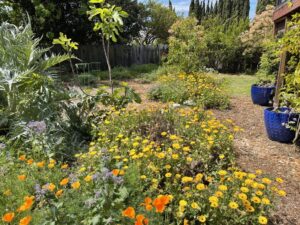 Morningside Botanical Bounty food forest was created as part of the Resilient Neighborhoods Program. This backyard garden has a laundry-to-landscape greywater system, fruit trees (pruned to keep them short and easy to harvest), swales, drip irrigation, bee-friendly plants, native plants and shade trees.
Morningside Botanical Bounty food forest was created as part of the Resilient Neighborhoods Program. This backyard garden has a laundry-to-landscape greywater system, fruit trees (pruned to keep them short and easy to harvest), swales, drip irrigation, bee-friendly plants, native plants and shade trees.
Native plant information will be available.
Pollinator Pathway
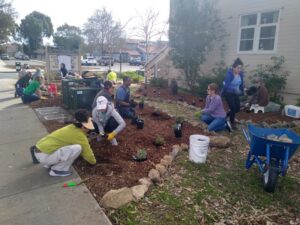 Pollinator food forest garden filled with a variety of California native plants that support the habitat of butterflies, bees, moths, wasps, hummingbirds and so much more. This garden was installed in February 2023 as a collaboration with a variety of organizations including Vallejo People’s Garden, Vallejo Project, Solano Resource Conservation District and Monarch Milkweed Project. Alanna Mirror wrote three songs inspired by the installation, featured in her Pollinator Pathway Lawn Transformation Mini Series!
Pollinator food forest garden filled with a variety of California native plants that support the habitat of butterflies, bees, moths, wasps, hummingbirds and so much more. This garden was installed in February 2023 as a collaboration with a variety of organizations including Vallejo People’s Garden, Vallejo Project, Solano Resource Conservation District and Monarch Milkweed Project. Alanna Mirror wrote three songs inspired by the installation, featured in her Pollinator Pathway Lawn Transformation Mini Series!
Master Gardeners, Solano Resource Conservation District and Vallejo People’s Garden will be on-site with information on how to support pollinators! They will be actively supporting the garden and weeding so the native plants can thrive; bring gloves if you want to participate. Join Suzanne Briley from Vallejo People’s Garden for a guided tour of native plants at 1 pm.
Vallejo Unity Garden (Vallejo Project)
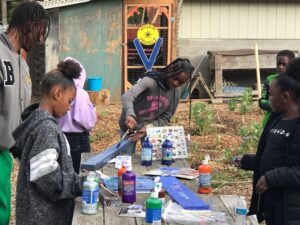 Vallejo Project’s Unity Garden initiative restored an abandoned lot that was once filled with sand and garbage and turned it into a multi-level food forest with internationally influenced farming techniques, a mealworm farm and chickens. This garden is focused on urban agriculture.
Vallejo Project’s Unity Garden initiative restored an abandoned lot that was once filled with sand and garbage and turned it into a multi-level food forest with internationally influenced farming techniques, a mealworm farm and chickens. This garden is focused on urban agriculture.
There will be seeds, plants or art from the garden for sale.
Vallejo Project imagines a Vallejo strengthened by new generations of youth and young adults who are inspired to give back to their community as role models, advocates, entrepreneurs, and leaders; who are able to efficiently articulate and implement solutions to challenges in the community based on their learned experience and knowledge gained through youth development programs.
Inspired Garden (Sure-Would Forest)
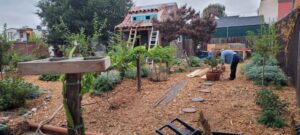
The homeowners had a nearly blank slate when they purchased this property in 2021, and soon started working on enriching the soil, retaining rainwater, and laying the groundwork for a food forest. This garden was inspired by Sustainable Solano gardens and a love of fresh fruit. In just over two years, they’ve gone from food desert to food forest with the ability to eat from their garden year round. They attended a design class taught by Joshua Burman Thayer with Native Sun Gardens in 2023 through Sustainable Solano’s backyard program. In June 2023 they hired Joshua to update the design and add drip irrigation.
Inspired by rainwater harvesting systems seen on the 2023 demonstration food forest tour, the homeowners bought and installed four IBC totes to collect water from their downspouts. The irrigation system for Sure-Would Forest is designed to feed from either city water or rainwater storage tanks, allowing over 1,000 gallons of rainwater to be used to irrigate the garden.
At 2 pm, the homeowner will talk about how he converted IBC totes to capture water and irrigate his garden.
We are incredibly grateful for the generous support of our funders. The first seven food forest gardens were made possible through funding from the Benicia Sustainability Commission; the Solano County Water Agency continues to support the Sustainable Backyard Program throughout the county. Solano Sustainable Backyard Program short videos: Waterwise and Building Gardens and Community. Occasionally we combine funding from other programs to make larger projects possible.

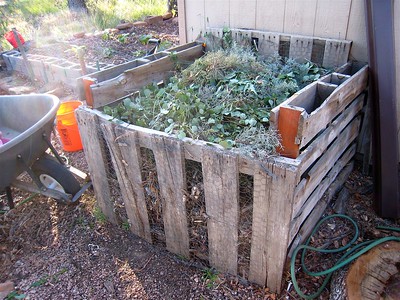 Soil health is a big focus for Sustainable Solano this year. This March through May, we’ll be offering classes for all levels of composting to build healthy soil. This series will consist of three classes, with a beginners composting class in March, an intermediate class in April and an advanced composting class in May. You are invited to attend the class of your choice or join us for all three to build your composting knowledge and connect with the different gardens where each class will be held.
Soil health is a big focus for Sustainable Solano this year. This March through May, we’ll be offering classes for all levels of composting to build healthy soil. This series will consist of three classes, with a beginners composting class in March, an intermediate class in April and an advanced composting class in May. You are invited to attend the class of your choice or join us for all three to build your composting knowledge and connect with the different gardens where each class will be held. Composting 101 will be followed by Intermediate Compost Skills – An Introduction to Worm Composting, also taught by Lori Caldwell. This class will go over compost mishaps and how to troubleshoot bin repair, pests, etc. The time will also be used to introduce worm composting, discussing the benefits of worms, worm castings, and this compost method that is very friendly for those who want to compost but have less space to work with. The Vallejo Project Unity Garden will be hosting this class, with a worm bin and a three-bin compost system that has been paused due to pest issues and repair needs. This class will be interactive and potentially hands on, as we hope to show examples of bin repairs and give their compost system a bit of TLC.
Composting 101 will be followed by Intermediate Compost Skills – An Introduction to Worm Composting, also taught by Lori Caldwell. This class will go over compost mishaps and how to troubleshoot bin repair, pests, etc. The time will also be used to introduce worm composting, discussing the benefits of worms, worm castings, and this compost method that is very friendly for those who want to compost but have less space to work with. The Vallejo Project Unity Garden will be hosting this class, with a worm bin and a three-bin compost system that has been paused due to pest issues and repair needs. This class will be interactive and potentially hands on, as we hope to show examples of bin repairs and give their compost system a bit of TLC.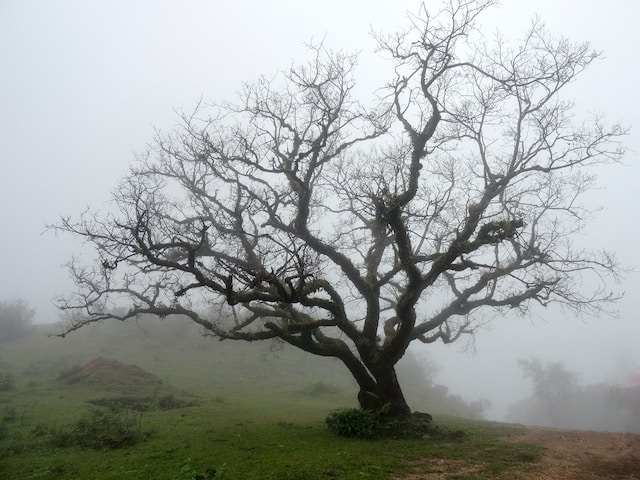
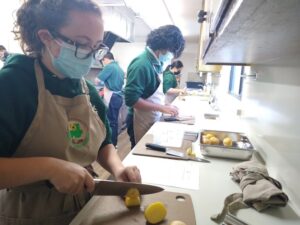 We’ve seen creative and innovative ways individuals, organizations and cities have supported such projects. In Berkeley, the Ecology Center runs
We’ve seen creative and innovative ways individuals, organizations and cities have supported such projects. In Berkeley, the Ecology Center runs